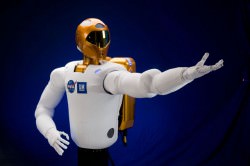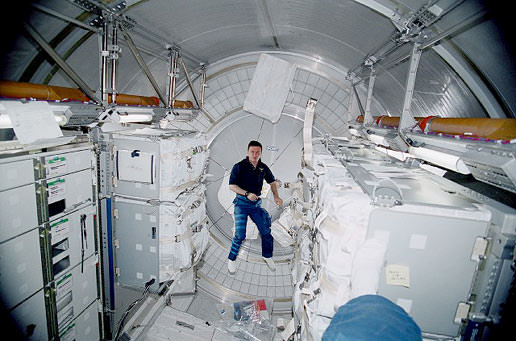[/caption]
There might be a new favorite hang-out for astronauts aboard the International Space Station later this year. The Multi Purpose Logistics Module (MPLM) known as Leonardo – which will be going to the ISS on the upcoming STS-131 mission carrying cargo and supplies — will be transformed after the mission into a Permanent Multipurpose Module (PMM), and brought up to stay on the station on STS-133 as a storeroom for supplies. But it might also become a haven to get away from it all.
“The thought is, the PMM might become sort of a ‘man cave’,” said Mike Kinslow, the Boeing payload manager out at Kennedy Space Center. “It won’t have all the background noise of fans, computers and other equipment running like in the laboratories, so it will be a quieter atmosphere that might appeal to the astronauts during their off-duty hours.”
No plans for a big screen TV Kinslow said, but there will be ports for computers, and since internet is now available on the ISS, Leonardo could be the location of choice to compose emails to loved ones back home, or do a little Twittering.

Another interesting piece of hardware scheduled to fly on the PMM is the Robonaut 2, NASA’s second generation of dexterous robots with a human-like torso that can work with tools and one day are envisioned to be able to do EVA work outside the ISS. But for now, R2 will be tested inside the station in zero-g. “It will be used on orbit for routine maintenance indoors only.” said Kinslow, “This is not an external unit.”
It has a “head” with a vision system, with hands that can do work, controlled by virtual-reality-like operation. Any chance R2 could be programmed to serve drinks or bring food into the man cave?
See our article on how General Motors is going to use R2 for manufacturing cars.
Turning Leonardo into a permanent module will take some work, said NASA Payload Manager Joe Delai. “Once it returns from this flight we will beef up the external shield and change things internally to become a permanent module. It will be about a four month process to get it ready.”

The MPLMs were built in Italy, but are owned by the U.S. and provided in exchange for Italian access to U.S. research time on the Station. Four modules were built; three flew to the ISS. STS-131 will be Leonardo’s seventh trip to space.
Kinslow said shields for an MPLM are lighter weight because they are only meant to be on orbit for 2 weeks at a time. “Leonardo will be plated with a multilevel Kevlar blanket, the same type of exterior shielding other modules have, which is similar to armor plating, to protect against meteorite or debris impact. Internally, not a lot of changes will be made,” he said. “It already has a ventilation system like a normal module, but will need a computer system and a few other additions.”
Leonardo won’t be outfitted with a sleep station or crew quarters because it might be in a more vulnerable position for radiation or debris hits. “They don’t really want crew to get in and sleep because of the shielding,” Kinslow said. “It will be a storage module, and we’re discussing putting exercise equipment in there.”
The PMM will be berthed on the Node 1 nadir, or Earth-facing port. Leonardo measures about 6.5 meters (21 feet) long and 4.5 meters (15 feet) in diameter.
STS-131 is currently scheduled for an April 5 launch, and STS-133 is shooting for a September 2010 launch.
Just a note on the ISS internet: T.J. Creamer, who is on board the station now told Universe Today that they aren’t able to have streaming video or download large files. “In terms of download speeds – you know, back in the old days, it kind of compares to 9.6 and the 14.4 kilobyte modems, so it’s not really fast enough to do large file exchange or videos, but it certainly lets us to do browsing and the fun reading we want to do, or get caught up on current events on that day. It’s a nice outreach for us, and of course you’ve heard about the Twittering which is a nice feature that we can partake in also.”

